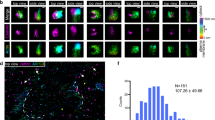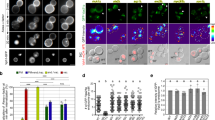Abstract
Longstanding evidence supports a role for actin in endocytosis; an intact actin cytoskeleton is required for endocytosis in yeast, and drugs that inhibit actin polymerization inhibit endocytosis in both yeast and mammalian cells. The yeast Arp2/3 complex is required for the internalization step of endocytosis. In addition, some early endocytic events in mammalian cells are associated with the formation of actin tails similar to those generated by activated Arp2/3 complex. However, until now no Arp2/3 complex activator has been identified among proteins known to mediate early steps in endocytosis. Here we show that the yeast endocytic protein Pan1p binds to and activates the Arp2/3 complex. Genetic interactions between PAN1 and mutants of Arp2/3 subunits, or of the Arp2/3 activator LAS17, provide evidence for this activity in vivo. We suggest that Pan1p forms the core of an endocytic complex and physically couples actin polymerization nucleated by the Arp2/3 complex to the endocytic machinery, thus providing the forces necessary for endocytosis.
This is a preview of subscription content, access via your institution
Access options
Subscribe to this journal
Receive 12 print issues and online access
$209.00 per year
only $17.42 per issue
Buy this article
- Purchase on Springer Link
- Instant access to full article PDF
Prices may be subject to local taxes which are calculated during checkout





Similar content being viewed by others
References
Winter, D., Lechler, T. & Li, R. Curr. Biol. 9, 501–504 (1999).
Li, R. J. Cell. Biol. 136, 649–658 (1997).
Moreau, V., Madania, A., Martin, R. P. & Winsor, B. J. Cell Biol. 134, 117–132 (1996).
Moreau, V., Galan, J.-M., Devilliers, G., Haguenauer-Tsapis, R. & Winsor, B. Mol. Biol. Cell 8, 1361–1375 (1997).
Wendland, B., McCaffery, J. M., Xiao, Q. & Emr, S. D. J. Cell Biol. 135, 1485–1500 (1996).
Tang, H.-Y., Xu, J. & Cai, M. Mol. Cell. Biol. 20, 12–25 (2000).
Wendland, B. & Emr, S. D. J. Cell Biol. 141, 71–84 (1998).
Wendland, B., Steece, K. E. & Emr, S. D. EMBO J. 18, 4383–4393 (1999).
Geli, M. I. & Riezman, H. J. Cell Sci. 111, 1031–1037 (1998).
Lechler, T., Shevchenko, A., Shevchenko, A. & Li, R. J. Cell Biol. 148, 363–373 (2000).
Geli, M. I. & Riezman, H. Science 272, 533–535 (1996).
Madania, A., Dumoulin, P., Grava, S., Kitamoto, H., Scharer-Brodbeck, C. et al. Mol. Biol. Cell 10, 3521–3538 (1999).
Lee, W.-L., Bezanilla, M. & Pollard, T. D. J. Cell Biol. 151, 789–799 (2000).
Evangelista, M., Klebl, B. M., Tong, A. H. Y., Webb, B. A., Leeuw, T. et al. J. Cell Biol. 148, 353–362 (2000).
Winter, D. C., Choe, E. Y. & Li, R. Proc. Natl Acad. Sci. USA 96, 7288–7293 (1999).
Machesky, L. M., Mullins, R. D., Higgs, H. N., Kaiser, D. A., Blanchoin, L. et al. Proc. Natl Acad. Sci. USA 96, 3739–3744 (1999).
Skoble, J., Portnoy, D. A. & Welch, M. D. J. Cell Biol. 150, 527–537 (2000).
Marchand, J. B., Kaiser, D. A., Pollard, T. D. & Higgs, H. N. Nature Cell Biol. 3, 76–82 (2001).
Wendland, B., Emr, S. D. & Riezman, H. Curr. Opin. Cell Biol. 10, 513–522 (1998).
Hao, W., Tan, Z., Prasad, K., Reddy, K. K., Chen, J. et al. J. Biol. Chem. 272, 6393–6398 (1997).
Itoh, T., Koshiba, S., Kigawa, T., Kikuchi, A., Yokoyama, S. et al. Science 291, 1047–1051 (2001).
Benedetti, H., Raths, S., Crausaz, F. & Riezman, H. Mol. Biol. Cell 5, 1023–1037 (1994).
Tebar, F., Sorkina, T., Sorkin, A., Ericsson, M. & Kirchhausen, T. J. Biol. Chem. 271, 28727–28730 (1996).
Guthrie, C. & Fink, G. R. Guide to Yeast Genetics and Molecular Biology (Academic, San Diego, 1991).
Longtine, M. S., McKenzie, A., Demarini, D. J., Shah, N. G., Wach, A. et al. Yeast 14, 953–961 (1998).
Mitchell, D. A., Marshall, T. K. & Deschenes, R. J. Yeast 9, 715–722 (1993).
Sachs, A. B. & Deardorff, J. A. Cell 70, 961–73 (1992).
Rodal, A. A., Tetreault, J. W., Lappalainen, P., Drubin, D. G. & Amberg, D. C. J. Cell Biol. 145, 1251–1264 (1999).
Goode, B. L., Rodal, A., Barnes, G., Drubin, D. G. J. Cell Biol. 153, 627–634 (2001).
Cope, M. J. T. V., Yang, S., Shang, C. & Drubin, D. G. J. Cell Biol. 144, 1203–1218 (1999).
Acknowledgements
We thank A. Sachs, B. Winsor, M. Cai, J. Skoble and J. Park for strains and reagents; A. Rodal for technical advice and helpful comments, M. Welch for critical reading of this manuscript; the Welch laboratory for helpful comments, advice and generously providing bench space; A. Sachs for Pan1p antibodies; and P. Crews (Univ. California, Santa Cruz) for latrunculin A. This work was supported by grants from the NIH–Institute of General Medical Sciences (D.G.D, B.W.), the Burroughs Wellcome Fund (B.W), the National Science Foundation (M.C.D.) and the Human Frontier Science Program (M.J.T.V.C.).
Author information
Authors and Affiliations
Corresponding author
Rights and permissions
About this article
Cite this article
Duncan, M., Cope, M., Goode, B. et al. Yeast Eps15-like endocytic protein, Pan1p, activates the Arp2/3 complex. Nat Cell Biol 3, 687–690 (2001). https://doi.org/10.1038/35083087
Received:
Revised:
Accepted:
Published:
Issue Date:
DOI: https://doi.org/10.1038/35083087
This article is cited by
-
New biomarkers underlying acetic acid tolerance in the probiotic yeast Saccharomyces cerevisiae var. boulardii
Applied Microbiology and Biotechnology (2024)
-
Distinct EH domains of the endocytic TPLATE complex confer lipid and protein binding
Nature Communications (2021)
-
Plant AtEH/Pan1 proteins drive autophagosome formation at ER-PM contact sites with actin and endocytic machinery
Nature Communications (2019)
-
Rapid, optimized interactomic screening
Nature Methods (2015)
-
Zooming in on the molecular mechanisms of endocytic budding by time-resolved electron microscopy
Cellular and Molecular Life Sciences (2014)



